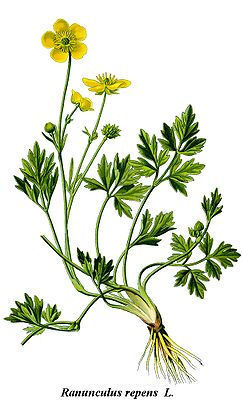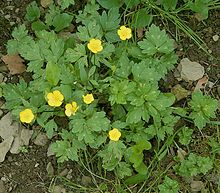Creeping buttercup
| Creeping buttercup | ||||||||||||
|---|---|---|---|---|---|---|---|---|---|---|---|---|

Creeping buttercup ( Ranunculus repens ) |
||||||||||||
| Systematics | ||||||||||||
|
||||||||||||
| Scientific name | ||||||||||||
| Ranunculus repens | ||||||||||||
| L. |
The creeping buttercup ( Ranunculus repens ) is a species of the genus buttercup ( Ranunculus ) in the buttercup family (Ranunculaceae).
description
The perennial herbaceous plant reaches stature heights of 10 to 50 cm. It got its name from the formation of creeping runners that can take root at the nodes (at the base of the leaf). The flowering period extends from May to August.
The leaves are pinnate to three, the leaflets three-lobed or lobed and serrated irregularly. The shiny golden yellow flowers have a diameter of 2 to 3 cm and arise individually from the leaf axils. The inflorescence consists of yellow colored nectar leaves and upright sepals adjoining the nectar leaves . Lonely nut fruits are formed.
Within the species there are many specimens that differ from one another in terms of the leaf cut, the flower size and the thickness of the hair. However, it is not possible to use these characteristics to distinguish lower-ranking clans from one another or to correlate them with specific locations.
The species is tetraploid , it usually has the chromosome number 2n = 32. The chromosome numbers 2n = 16 or 28 are less common.
ecology
The creeping buttercup is a hemicryptophyte (half rosette plant) with runners and often evergreen. It roots up to 50 cm deep. When growing on wet soils, its bark has large intercellular spaces . It is fast-growing - sturdy plants can be grown within a month after germination .
The flowers are homogeneous to pre-male "nectar-carrying disc flowers". They consist of 5 cup-like tepals and 5 corolla-like nectar leaves with basal scales, under which the nectar gland is located. In addition to plants with hermaphrodite flowers, there are also purely female plants (= gyno-dioecious). Pollinators are different insects . When it rains, the bowl-shaped flowers stay open so that water collects in them and the pollen can finally swim to the stigmas. It has been experimentally proven that such rainwater pollination also leads to seed formation.
Numerous nuts emerge as fruits per blossom . The plant is a wind and animal spreader, in addition, water adhesion and chance spread by grass eaters. Vegetative reproduction occurs through long, above-ground runners of the strawberry type.
Toxicity
With about 0.01% protoanemonin in the herb, the creeping buttercup is only slightly poisonous.
Occurrence
The creeping buttercup can be found widespread in pioneering societies, on fields, in fallow land and gardens, on banks, ditches and paths, in meadows and alluvial forests. It prefers damp, stony, humus-containing or raw loam and clay soil, at least at times; he also walks on compacted soil and also endures flooding. In the mountains it can be found up to an altitude of about 2400 m above sea level. In the Allgäu Alps in Bavaria, it rises to the Rappenseehütte up to 2090 meters above sea level. According to Ellenberg , it is a moisture indicator and an order character of the fingerweed and white ostrich grass creeping turf (Agrostietalia stoloniferae). According to Oberdorfer , it is a character species of the Agropyro-Rumicion association, but also occurs as a disturbance indicator in associations of the Magnocaricion, Calthion, Alno-Ulmion and Salicion albae associations.
The natural range includes Europe, Asia and North Africa; The creeping buttercup was introduced in North America, Australia ( Tasmania ), New Zealand and even in the Antarctic .
The creeping buttercup is considered an annoying weed by farmers and hobby gardeners. It drives runners in all directions, which take root at the nodes at certain intervals and develop clusters of basal leaves. This means that large areas can be covered with this plant in a short time.
literature
- Manfred A. Fischer , Wolfgang Adler, Karl Oswald: Excursion flora for Austria, Liechtenstein and South Tyrol. 2nd, improved and enlarged edition. State of Upper Austria, Biology Center of the Upper Austrian State Museums, Linz 2005, ISBN 3-85474-140-5 .
- Gunter Steinbach (Ed.), Bruno P. Kremer u. a .: wildflowers. Recognize & determine. Mosaik, Munich 2001, ISBN 3-576-11456-4 .
- Erich Oberdorfer : Plant-sociological excursion flora for Germany and neighboring areas. 8th edition, Ulmer-Verlag, Stuttgart 2001, ISBN 3-8001-3131-5 .
- Heinz Ellenberg : Vegetation of Central Europe with the Alps from an ecological, dynamic and historical perspective. 5th, heavily changed and improved edition. Ulmer, Stuttgart 1996, ISBN 3-8001-2696-6 .
- Ruprecht Düll , Herfried Kutzelnigg : Pocket dictionary of plants in Germany. A botanical-ecological excursion companion to the most important species. 6th, completely revised edition. Quelle & Meyer, Wiebelsheim 2005, ISBN 3-494-01397-7 .
- Dietmar Aichele, Heinz-Werner Schwegler: The flowering plants of Central Europe, Volume 2. Franckh-Kosmos-Verlag, 2nd edition.
Web links
- Creeping buttercup. In: FloraWeb.de.
- Creeping buttercup . In: BiolFlor, the database of biological-ecological characteristics of the flora of Germany.
- Profile and distribution map for Bavaria . In: Botanical Information Hub of Bavaria .
- Ranunculus repens L. In: Info Flora , the national data and information center for Swiss flora . Retrieved October 19, 2015.
- Map of the overall distribution at linnaeus.nrm.se
- Thomas Meyer: Data sheet with identification key and photos at Flora-de: Flora von Deutschland (old name of the website: Flowers in Swabia )
- Entry at GRIN
Individual evidence
- ↑ Jaakko Jalas, Juha Suominen: Atlas florae europaeae . Volume 8 (Nymphaeaceae to Ranunculaceae). Page 123, Helsinki 1989. ISBN 951-9108-07-6 .
- ^ Ranunculus repens at Tropicos.org. In: IPCN Chromosome Reports . Missouri Botanical Garden, St. Louis
- ↑ Information on toxicity at giftpflanze.com .
- ↑ Erhard Dörr, Wolfgang Lippert : Flora of the Allgäu and its surroundings. Volume 1, IHW, Eching 2001, ISBN 3-930167-50-6 , p. 539.
- ^ Erich Oberdorfer : Plant-sociological excursion flora for Germany and neighboring areas . With the collaboration of Angelika Schwabe and Theo Müller. 8th, heavily revised and expanded edition. Eugen Ulmer, Stuttgart (Hohenheim) 2001, ISBN 3-8001-3131-5 , pp. 410 .


